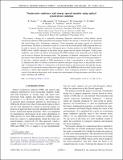| dc.contributor.author | Fiorito, R. | |
| dc.contributor.author | Shkvarunets, A. | |
| dc.contributor.author | Castronovo, D. | |
| dc.contributor.author | Cornacchia, M. | |
| dc.contributor.author | Di Mitri, S. | |
| dc.contributor.author | Kishek, R. | |
| dc.contributor.author | Veronese, M. | |
| dc.contributor.author | Tschalar, Christoph | |
| dc.date.accessioned | 2014-12-22T19:41:46Z | |
| dc.date.available | 2014-12-22T19:41:46Z | |
| dc.date.issued | 2014-12 | |
| dc.date.submitted | 2014-03 | |
| dc.identifier.issn | 1098-4402 | |
| dc.identifier.uri | http://hdl.handle.net/1721.1/92448 | |
| dc.description.abstract | We propose a design for a minimally perturbing diagnostic minichicane, which utilizes optical synchrotron radiation (OSR) generated from magnetic bends in the chicane, to measure the rms horizontal and vertical beam sizes, divergences, emittances, Twiss parameters and energy spread of a relativistic electron beam. The beam is externally focused to a waist at the first bend and the OSR generated there can be used to measure the rms beam size. Subsequent pairs of bends produce far field OSR interferences (OSRI) whose visibility depends on the beam energy spread and the angular divergence. Under proper conditions, one of these two effects will dominate the OSRI visibility from a particular pair of bends and can be used to diagnose the dominant effect. The properties of different configuration of bends in the chicane have been analyzed to provide an optimum diagnostic design for a given set of beam parameters to: (1) provide a sufficient number of OSR interferences to allow a measurement of the fringe visibility; (2) minimize the effect of coherent synchrotron radiation and space charge forces on the particles motion; and (3) minimize the effect of compression on the bunch length as the beam passes through the chicane. A design for the chicane has been produced for application to the FERMI free electron laser facility and by extension to similar high brightness linear accelerators. Such a diagnostic promises to greatly improve control of the electron beam optics with a noninvasive measurement of beam parameters and allow on-line optics matching and feedback. | en_US |
| dc.description.sponsorship | United States. Office of Naval Research | en_US |
| dc.description.sponsorship | Elettra Sincrotrone Trieste (FERMI Project Grant FIRB-RBAP045JF2) | en_US |
| dc.description.sponsorship | Elettra Sincrotrone Trieste (FERMI Project Grant FIRB-RBAP06AWK3) | en_US |
| dc.publisher | American Physical Society | en_US |
| dc.relation.isversionof | http://dx.doi.org/10.1103/PhysRevSTAB.17.122803 | en_US |
| dc.rights | Creative Commons Attribution | en_US |
| dc.rights.uri | http://creativecommons.org/licenses/by/3.0 | en_US |
| dc.source | American Physical Society | en_US |
| dc.title | Noninvasive emittance and energy spread monitor using optical synchrotron radiation | en_US |
| dc.type | Article | en_US |
| dc.identifier.citation | Fiorito, R., A. Shkvarunets, D. Castronovo, M. Cornacchia, S. Di Mitri, R. Kishek, C. Tschalaer, and M. Veronese. “Noninvasive Emittance and Energy Spread Monitor Using Optical Synchrotron Radiation.” Phys. Rev. ST Accel. Beams 17, no. 12 (December 2014). | en_US |
| dc.contributor.department | Massachusetts Institute of Technology. Laboratory for Nuclear Science | en_US |
| dc.contributor.mitauthor | Tschalaer, Christoph | en_US |
| dc.relation.journal | Physical Review Special Topics - Accelerators and Beams | en_US |
| dc.eprint.version | Final published version | en_US |
| dc.type.uri | http://purl.org/eprint/type/JournalArticle | en_US |
| eprint.status | http://purl.org/eprint/status/PeerReviewed | en_US |
| dc.date.updated | 2014-12-19T23:00:07Z | |
| dc.language.rfc3066 | en | |
| dc.rights.holder | authors | |
| dspace.orderedauthors | Fiorito, R.; Shkvarunets, A.; Castronovo, D.; Cornacchia, M.; Di Mitri, S.; Kishek, R.; Tschalaer, C.; Veronese, M. | en_US |
| dc.identifier.orcid | https://orcid.org/0000-0002-6337-331X | |
| mit.license | PUBLISHER_CC | en_US |
| mit.metadata.status | Complete | |
